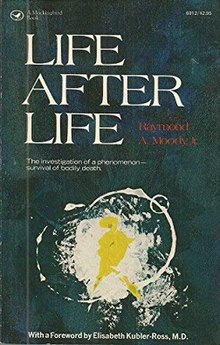 First edition | |
| Author | Raymond A. Moody |
|---|---|
| Publisher | Mockingbird Books |
Publication date | 1975 |
| Media type | |
| Pages | 175 |
| ISBN | 978-0-89176-037-5 |
| OCLC | 12173853 |
Life After Life is a 1975 book written by psychiatrist Raymond Moody. It is a report on a qualitative study in which Moody interviewed 150 people who had undergone near-death experiences (NDEs). The book presents the author's composite account of what it is like to die, supplemented with individual accounts.[1][2] On the basis of his collection of cases, Moody identified a common set of elements in NDEs:[3]
- (a) an overwhelming feeling of peace and well-being, including freedom from pain.
- (b) the impression of being located outside one's physical body.
- (c) floating or drifting through darkness, sometimes described as a tunnel.
- (d) becoming aware of a golden light.
- (e) encountering and perhaps communicating with a "being of light".
- (f) having a rapid succession of visual images of one's past.
- (g) experiencing another world of much beauty.[3]
Life After Life sold more than 13 million copies,[4] was translated into a dozen foreign languages[5] and became an international best seller, which made the subject of NDEs popular and opened the way for many other studies.[6][7]
Reception
[edit]Moody's alleged evidence for an afterlife was heavily criticized as flawed, both logically and empirically.[8] The psychologist James Alcock has noted that "[Moody] appears to ignore a great deal of the scientific literature dealing with hallucinatory experiences in general, just as he quickly glosses over the very real limitations of his research method."[9]
The philosopher Paul Kurtz has written that Moody's evidence for the NDE is based on personal interviews and anecdotal accounts and there has been no statistical analyses of his data. According to Kurtz, "there is no reliable evidence that people who report such experiences have died and returned, or that consciousness exists separate from the brain or body."[10]
References
[edit]- ^ Clifton D. Bryant (2003). Handbook of Death and Dying Sage, p.138.
- ^ Michael Marsh. Review: Beyond Death: The Rebirth of Immortality The Hastings Center Report, Vol. 7, No. 5 (Oct., 1977), pp. 40–42.
- ^ a b Harvey J. Irwin and Caroline Watt. An introduction to parapsychology McFarland, 2007, p. 159.
- ^ Towards the light The Age, March 23, 2004.
- ^ Louis E. LaGrand (1999), Messages and miracles: extraordinary experiences of the bereaved, St. Paul, MN: Llewellyn Worldwide, p. 9, ISBN 1-56718-406-5
- ^ Harvey J. Irwin, Caroline Watt (2007). An introduction to parapsychology McFarland, p. 158.
- ^ Duane S. Crowther (2005). Life Everlasting Cedar Fort, p. 19.
- ^ Barry Beyerstein. (1990). Evaluating the Anomalous Experience. In Kendrick Frazier. The Hundredth Monkey and Other Paradigms of the Paranormal. Prometheus Books. pp. 43–53. ISBN 0-87975-655-1
- ^ James Alcock. (1981). Psychology and Near-Death Experiences. In Kendrick Frazier. Paranormal Borderlands of Science. Prometheus Books. pp. 153–169. ISBN 0-87975-148-7
- ^ Paul Kurtz. (1991). Toward a New Enlightenment: The Philosophy of Paul Kurtz. Transaction Publishers. p. 349. ISBN 1-56000-118-6